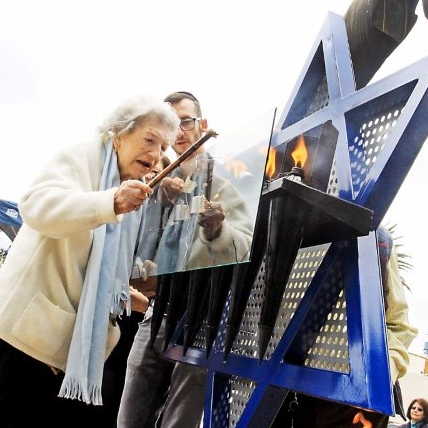
News

Warsaw Ghetto Uprising remembered on Yom Hashoah
MIRAH LANGER
“We remember those who refused to passively accept their fate but fought back in every way – in the ghettos and the death camps, as partisans in the forest and in the underground resistance,” said the SA Jewish Board of Deputies’ Gauteng Council chairman Marc Pozniak in introducing this year’s commemoration of the 75th anniversary of the Warsaw Ghetto Uprising.
“In doing so, they lit a flame of defiance that resonates amongst us still today – strengthening our resolve to ensure that the Jewish people will never again be at the mercy of those who seek our destruction,” he told those gathered at the Memorial to the Six Million Monument at the Johannesburg cemetery.
Following his address, poetry was read out, as well as the names of the dead. Each victim’s name, place of birth and then age, place and date of death was announced. But the list did not bear the names of millions more who were murdered.
Then came the acknowledgement of those who survived.
“We pay tribute to them… for the strength and the courage that they showed in rebuilding their lives as good citizens, committed family members and loyal Jews,” said Pozniak.
Yet, he continued: “We must never lose sight of the fact that the ultimate aim of the Nazi regime was to destroy the entire Jewish people… So, in a deeper sense, we too, each of us, must regard ourselves as being survivors of the Holocaust,” he asserted.
However, added Pozniak, each generation could not take this status for granted.
“Being a survivor carries with it a responsibility… to infuse our lives with meaning; to contribute in whatever way we can to building a world founded on justice and compassion.”
The hope was that by doing so, he said, “we help to give meaning to those who died. But perhaps more so, we give meaning to our own survival.”
The stage was then filled with a procession of survivors, who each lit a memorial lamp. The Partisan Song was then sung.
The stark realities of the Warsaw Ghetto were brought into chilling focus by the keynote address of survivor Irene Klass.
Born in Lodz, Poland, Klass remembered how, after the outbreak of war, Jews began to be identified first with a white band and blue star, and later, with the infamous yellow star insignia.
“Even babies had to wear the yellow star,” she recalled.
Klass detailed how her family were separated when the Warsaw Ghetto was established. While her father, who “didn’t look Semitic” and could speak German, managed to get false papers and live outside the ghetto, she and her mother, uncle and grandmother moved into one room within the barricades.
The conditions they experienced were terrible: disease, starvation and security guards who would shoot on the spot anyone who attempted to escape the ghetto walls.
“People were dying faster than they could be buried. They were found lying in the streets covered with newspapers.” Such were the images that scarred Klass’s childhood.
After some time, Klass’s father managed to get papers for her, but not her mother: “I will never forget standing on the staircase of the burning ghetto, at 10 years old, saying goodbye to my mother, not knowing if I would ever see her again.”
While her father met her outside, Klass could not be with him for safety reasons and instead, was taken to a place of hiding. He visited her every few weeks, pretending to be her uncle.
“Then he stopped coming and I didn’t know what happened…”
Klass was forced to earn money or else the woman with whom she was staying would not keep looking after her. She began to sell soap and combs on the street.
Klass also remembered how, a year after the Warsaw Ghetto Uprising, there was an uprising by Polish people in Warsaw against Nazi occupation.
German soldiers then marched residents to a city square “with guns to our backs”.
However, that day, the Germans changed their minds and instead took the people to transit camps.
Eventually, Klass was rescued from the camp by an aunt, who disguised herself as a nurse and made Klass put flour on her face to look as if she had typhus, in order to take her away.
In the interim, Klass’s mother also escaped by walking through a sewer, after which she was taken to a hiding place: “an attic like Anne Frank… She moved about on her hands and knees, so nobody would see her.”
The three women were later reunited.
However, when it came to her father, “I still don’t know until this day what happened… He was one of the six million,” Klass told the audience.




